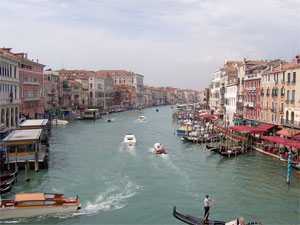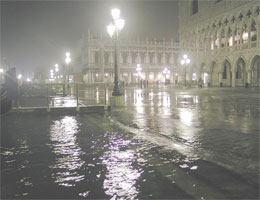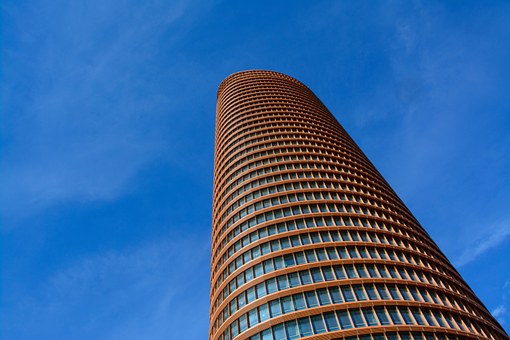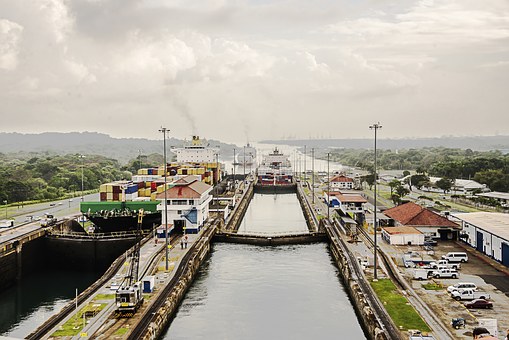The city of Venice is an engineering masterpiece. From the well-known St. Mark’s Square to the infamous Bridge of Sighs, the city was built entirely on water. The early engineers of the city had to choose specific materials suited to marine conditions, and they developed unique techniques for constructing the historic buildings we see today. However, the precious city of Venice has begun to sink at an alarming rate, threatened by increasing water levels and ever-frequent flooding. The proposed solution to the problem is the MOSE project, consisting of 79 mobile floodgates that will, when raised, seal off the lagoon from the Adriatic Sea, thus preventing unusually high tides from damaging the city. As we take a look at the history of Venice, from its original planning and construction to the new problems it faces today, we will see how understanding the city’s engineering past may provide the means to preserving it for generations to come.
“Venice! Venice! When thy marble walls are level with the waters, there shall be a cry of nations o’er thy sunken halls, a loud lament along the sweeping sea!Lord Byron [1]
Introduction
Lord Byron’s prophetic verse from his poem “Ode on Venice,” captures the sentiment felt by many who have walked the streets and seen the fabled canals of Venice, Italy. Unfortunately, Venice has been plagued by sinking foundations and rising water levels that threaten to destroy this engineering wonder. This has spurred an international effort to save the city of Venice from becoming a watery grave. By learning about Venice’s planning and construction, while also observing Venice’s present challenge of solving its flooding problems, we will better understand how it is necessary for engineers to continually adapt to solve the unprecedented challenges that Venice faces.
The Foundations of Venice
The city of Venice was built in the early 1500’s A.D. on a collection of 117 low islands at the center of a lagoon. The numerous canals provided an ideal location for a city because they formed a natural defense against foreign attackers, similar to a moat [2]. In order to build a city above the water, early architects had to build stable foundations that were sunk deep into a bed of compounded silt and sand called subsoil. The construction material of choice for these foundations was wood stakes from native alder trees [3]. Wood made an ideal foundation material because the submerged wood was not exposed to air, which inhibited deterioration and rotting. In addition, the wood provided a strong, yet flexible support that could resist the constant movement of the tides [3]. These alder stakes supported a horizontal wooden platform of elm and larch (called zatterone, or “large rafts”), where foundation walls of large stone blocks were built.
These foundation blocks were made of a type of stone called Kirmenjak. Its unique properties – extremely low water absorption and high strength to support large buildings without weakening – made it an ideal material for Venetian foundations. This prevented water from creeping up through the stones (called rising damp) and into the vulnerable brickwork [4]. Atop these stable foundations, architects built the magnificent buildings we see today, which are made of brick and often have marble facades. The foundations of Venice provide a great example of the specific planning and careful material choices that made this city-on-the-water a reality (see Fig. 1).
Construction of the City
The actual construction of the foundations was an intensive process that involved months of planning. The preparation for the site started with creating a dense wall of wood pilings and wooden planks along a canal to keep water out of the foundations during construction. The site was then drained of water, and the alder stakes were driven into the subsoil. The land was then built up with layers of crushed brick and stone to three meters under the high tide level [3]. This is where the wood zatterone planks were built, to distribute building weight across the soft ground. A building was vulnerable to subsidence or foundation failure if the loads were not evenly distributed across the zatterone. The waterproof Kirmenjak stones were then stacked on top of the zatterone, completing the base foundation of the building [3].
Venetian architects most commonly used brick in their structures because it was economical, easily dried out, and relatively lightweight. The bricks were held together with limestone mortar, which provided flexibility and allowed for movement on the foundations due to tidal currents. These building techniques have proved to be surprisingly resilient and have allowed some Venetian buildings to survive over 400 years. However, a new threat has now arrived in the form of rising tides and subsiding foundations – these threaten to flood the city and potentially destroy many of its historic engineering masterpieces.
Venice: A Sinking City
On November 4, 1966, the water levels in the Venice Lagoon rose to 196 cm above sea level, submerging everyone in Piazza San Marco (the city’s main gallery area) in chest high water. The ground floors of countless buildings were flooded and the residents’ possessions were ruined. Flooding is especially harmful to the buildings of Venice; if water reaches the porous brick, then it rises by capillary action to the higher walls and then erodes the walls and marble [2]. The cause of the flooding was a strong southeast wind that prevented the normal turning of the tides for eight hours. The flooding caused incalculable damage across Venice, and it brought international attention upon the city [5]. Since the 1966 flooding, scientists have been researching the increased frequency of flooding in Venice, and they have identified two main sources: Venice has been slowly been sinking, while global water levels have risen due to melting polar ice caps.
Research shows that Venice has subsided a total of 15-16 cm since 1900. Just 3-4 cm are accounted for by natural subsidence, while 12 cm can be traced back to the pumping of ground water from aquifers below the city, until the Sile aqueduct was constructed in 1975 [2]. This sinking has been coupled with a 7-8 cm rise in global water levels, allowing for an overall change of 23 cm relative to sea level. While this may not seem like very much, it actually represents a very significant change: Piazza San Marco flooded 121 times in 2004, as opposed to just 7 times per year in the 1900s [6]. And the flooding is predicted to worsen. According to estimates by the Intergovernmental Panel on Climate Change (IPCC), global water levels will rise approximately 20 cm by 2050, and 49 cm by 2100. “Yet, a total rise in sea level of only 30 centimeters would mean that St Mark’s Square is flooded more than 360 times a year” [2]. The threat of flooding to the city of Venice has been a pressing issue, and after years of preparation, a plan in 2003 was finally approved to help save Venice from further damage and future floods.
The MOSE Project
The MOSE project was first proposed in 1989, and is an ambitious project aimed at solving Venice’s flooding problem. MOSE stands for Modulo Sperimentale Elettromeccanico (Experimental Electromechanical Module) and refers to Moses’ parting of the Red Sea [6]. The project was accepted in 2003 and is currently under construction (see Fig. 2).
The MOSE project consists of a series of 79 mobile floodgates, distributed among the three entrances to the lagoon. Each metal floodgate measures 20 meters wide, 20-30 meters high, and 4-5 meters thick. During normal tides, these floodgates lie flat on the sea floor in concrete beds, out of sight. However, if water levels were to rise above 100 cm, then the gates would fill with compressed air, causing them to pivot upwards to a 60 degree angle and rise out of the water [7]. These gates would effectively block water flow into the lagoon, keeping the water level of the lagoon below that of the Adriatic Sea, thus preventing flooding. They would remain up for about 4.5 hours, until the tides subside.
Because of the enormity of the MOSE project, it is estimated to cost between $4-6 billion, and is scheduled to be completed by 2012 [7]. In addition to the floodgates, smaller-scale works will protect the city from “normal” flooding that is not enough to merit raising the floodgates. These projects include building breakwaters at the three inlets, “building small barriers to protect low-lying buildings, dredging some of the natural channels…, and replanting marsh grass on the lagoon’s mud banks,” [8]. These smaller works are also meant to complement the larger scale MOSE project and help prevent some of the damage caused by flooding.
Environmental Impact
Many environmentalists are very skeptical of the natural impact of the new MOSE system. Extensive testing and simulations have shown that its effect on the lagoon is minimal when the gates are down [9]. However, critics claim that raised floodgates would block normal water currents and adversely affect the wildlife of Venice Lagoon. Studies have shown that the “[l]agoon, also, has become increasingly polluted” [2], and that the gates will trap the pollutants and “make the city unlivable for long periods, as sewage normally flushed from the lagoon remains behind,” [6]. However, not all efforts have had an adverse environmental reaction.
Marine biologists have found that the breakwater barriers that have been constructed in front of the three lagoon entrances have encouraged the growth of coral reef. These scientists have discovered “more than 150 different species,’ of marine life living in the reef. Due to global warming, the waters have become warm enough to support “fish and coral that were previously found only in the southern Mediterranean and Red Sea” [10]. These surprising results show how unpredictable the environmental impact of large scale projects can be. For now, we can only guess at the effects of the implementation of mobile flood gates, and only time will tell what its true environmental impact will be.
Conclusion
The city of Venice provides a great example of how engineering technology has evolved over the centuries. From the past challenges of constructing an entire city on water to the present problems of saving a city from flooding, engineers have had to adapt and change their methods to provide solutions to pressing issues. The MOSE solution to Venice’s flooding problem is an ambitious project that has required almost two decades of planning and testing. If it succeeds in preventing rising water levels from flooding the city, it will save Venice for future generations to enjoy.




